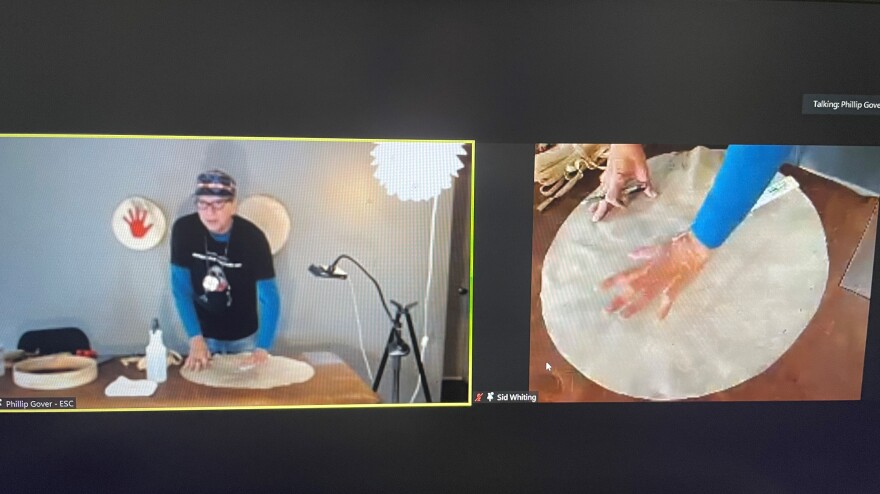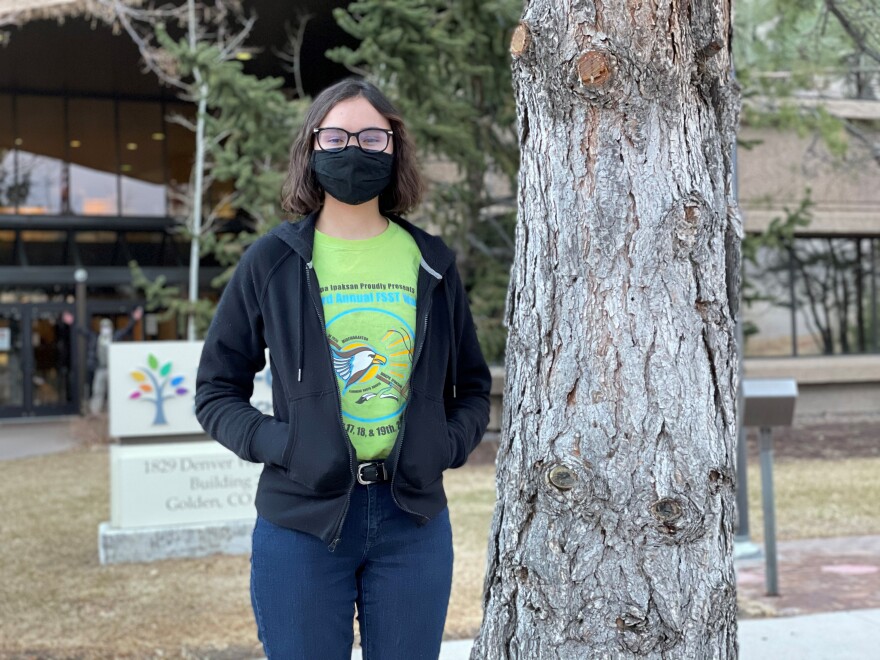Jeffco Public Schools recently co-hosted a virtual drum-making event for Indigenous students and families living in metro Denver. District staff hand-delivered the materials to participants beforehand. The kits included the rawhide drumhead, the frame, the lace that ties it together and the drumstick.
The instructor is Sid Whiting, a cultural academics presenter for local school districts and member of the Sicangu Lakota, Rosebud Sioux Nation.
“These chunchegas, these drums that we’re going to be working with,” he said, “they do have a spirit of their own and we have to allow and accommodate that spirit to be brought into this world.”
Whiting says a quick prayer to purify and bless the drums, then it’s time to get to work. He asks the participants to lay the wet drumhead out flat, smooth side down.
“What we're going to do is make sure we have our tools, he said. “What you're going to need is a pen or a pencil to make a mark on your drum.”
'Cultural perspective'
The event is part of Jeffco’s federally funded Indian Education Program. It addresses the educational and cultural needs of the district’s American Indian, Alaska Native and Native Hawaiian students, who make up 1.5% of the student population, and their parents.
The Indian Education Program works with the district and teachers to adapt the curriculum to be more Indigenous-focused and culturally responsive to Native American students. It is important for students to have an organization that represents them, said Chenoa Crowshoe-Patterson, the program’s equity and diversity specialist, and have district staff that look like them.
“I think it helps them be able to relate culturally to certain programming by offering a cultural perspective. Such as a cultural perspective on math or a cultural perspective on history,” she said. “I think that’s really important for students’ learning.”
'Learned more about myself'
Deelia Sherman, a junior at Stanley Lake High School in Westminster, sits on Jeffco’s Indian Education Student Council. She joined last spring after schools were closed due to the pandemic. She meets with the council weekly and has attended classes like pow wow dance and the recent drum-making event.

“It was really cool to learn about,” she said. “The instructor teaching us, told us a lot about how we put our spirit into our drums to make them like our own.”
Sherman is half-Native American; her father is enrolled in the Flandreau Santee Sioux Tribe.
“Whenever we learned about Native Americans in school, I always was kind of confused about that. And I always felt kind of torn,” she said. “So being able to be more involved in the community and talk to other people who deal with the same issues and things like that has helped me a lot. And I've learned more about myself and about like where I am in the world.”
'Culture is prevention'
Increasing these cultural connections is the foundation of the Indian Education’s substance abuse prevention efforts. In Sept. 2019, Jeffco received money from the state’s Opioid Response Grant to implement a two-year program, which started during the 2019-2020 school year.
The 2019 Healthy Kids Colorado Survey asked nearly 50,000 high school students about their drug and alcohol use. It found Native Hawaiian or other Pacific Islander and American Indian or Alaska Native teens are using hard drugs, including prescription pain medicine, heroin and methamphetamines at higher rates than the state average.
This is a huge issue, said Shelly Solopow, tribal liaison for Colorado’s Office of Behavioral Health. While treatment and intervention may be needed, prevention and stopping drug use before it starts is also important.
“Currently in prevention, as a general rule, we’re seeing that spending a little bit more energy on resilience or building up those factors in life that protect you from various other things seem to be the best outcome for the dollar,” she said.
The goal of the program is to provide culturally responsive prevention services that increase protective factors to reduce drug and alcohol use.
“The concept of 'culture is prevention' means that youth and families are provided the opportunity to reconnect with their culture and traditions,” said Audrienna Brady, Jeffco’s Indian Education substance use prevention specialist.
This includes guest speakers and artists, language revitalization, learning about Indigenous foods and hands-on events like drum-making and creating ledger art.
“That was a tribute to the narrative drawing on paper or cloth that is practiced by Lakota, Dakota, Nakota or other Plains Tribes,” said Brady.
While a higher percent of Indigenous youth are using drugs and alcohol than their peers, Brady said their program is more focused on helping these teens make healthy choices.
“Looking at our Indigenous identity and our traditions, cultures and practices to strengthen us and remind our students and families that these traditions are a form of resilience,” she said.
The 2019 survey also found the percentage of Indigenous youth who felt sad or hopeless or seriously considered or attempted suicide was above the state average. The Indian Education Program also works with Jeffco’s mental health staff to help them provide culturally relevant coping tools. One is smudging, a traditional purification ritual.
“Or maybe (they) turn to us about how we can provide like maybe a cedar blessing. Or maybe say a prayer for them in our native language,” she said. “To help them through maybe difficult times.”
'Connecting these kids'
The Healthy Kids Colorado survey is administered by the state every two years, and the most recent data was collected before the pandemic. Experts say the stress and trauma caused by COVID-19 has only increased substance abuse and mental health issues.
The Indian Education Program is addressing coronavirus concerns as well. As they listen to parents and students, Brady said, they have found common issues like difficulty reaching teachers, parents concerned about school absences and, with schools closed, too many people at home.
“We’re trying to get our voices out there, let families know we’re here to support them,” she said.
For Sherman, the weekly student council meetings and ongoing cultural events are something to look forward to. She really enjoyed learning ledger art and said it has gotten easier to make drums.
“I think it's really important that this Indian education program is connecting these kids who can sometimes feel kind of isolated and confused,” she said. “Give them that outlet to learn about themselves and learn about their culture and things.”






